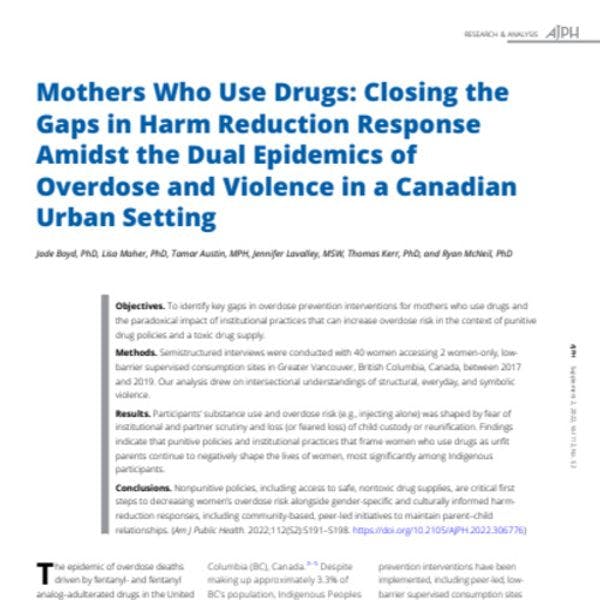Mothers who use drugs: Closing the gaps in harm reduction response amidst the dual epidemics of overdose and violence in a Canadian urban setting
By Jade Boyd, PhD, Lisa Maher, PhD, Tamar Austin, MPH, Jennifer Lavalley, MSW, Thomas Kerr, PhD, and Ryan McNeil, PhD / American Journal of Public Health (AJPH)
Abstract
Objectives. To identify key gaps in overdose prevention interventions for mothers who use drugs and the paradoxical impact of institutional practices that can increase overdose risk in the context of punitive drug policies and a toxic drug supply.
Methods. Semistructured interviews were conducted with 40 women accessing 2 women-only, low-barrier supervised consumption sites in Greater Vancouver, British Columbia, Canada, between 2017 and 2019. Our analysis drew on intersectional understandings of structural, everyday, and symbolic violence.
Results. Participants’ substance use and overdose risk (e.g., injecting alone) was shaped by fear of institutional and partner scrutiny and loss (or feared loss) of child custody or reunification. Findings indicate that punitive policies and institutional practices that frame women who use drugs as unfit parents continue to negatively shape the lives of women, most significantly among Indigenous participants.
Conclusions. Nonpunitive policies, including access to safe, nontoxic drug supplies, are critical first steps to decreasing women’s overdose risk alongside gender-specific and culturally informed harm-reduction responses, including community-based, peer-led initiatives to maintain parent–child relationships.
(Am J Public Health. 2022;112(S2):S191–S198. https://doi.org/10.2105/AJPH.2022.306776)
